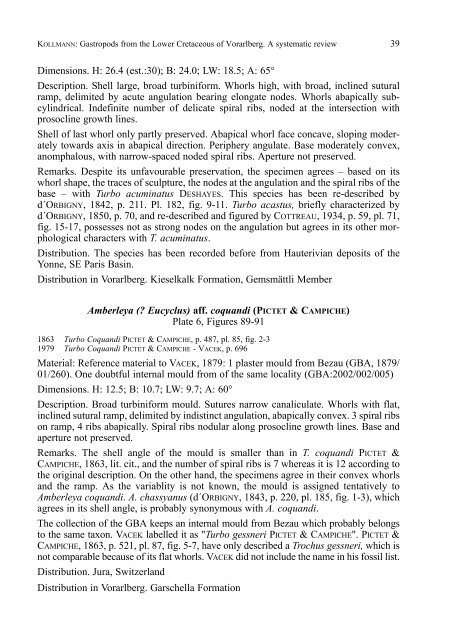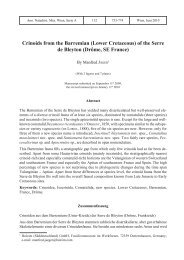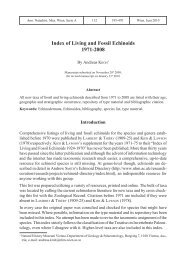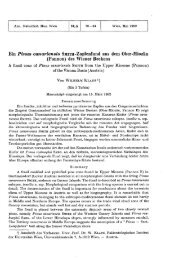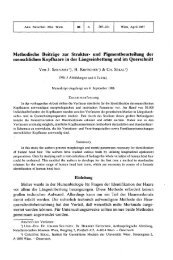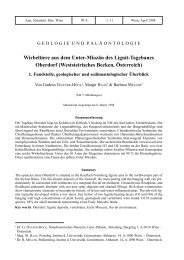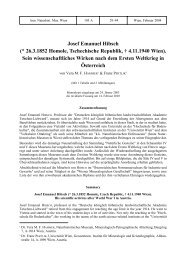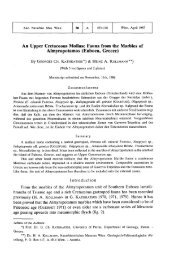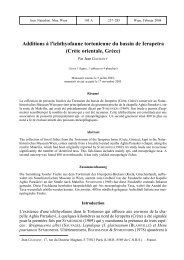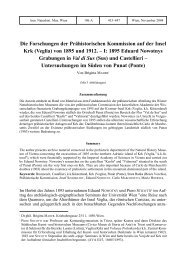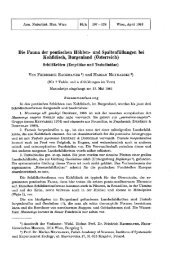Gastropods from the Lower Cretaceous of Vorarlberg, Austria. A ...
Gastropods from the Lower Cretaceous of Vorarlberg, Austria. A ...
Gastropods from the Lower Cretaceous of Vorarlberg, Austria. A ...
You also want an ePaper? Increase the reach of your titles
YUMPU automatically turns print PDFs into web optimized ePapers that Google loves.
KOLLMANN: <strong>Gastropods</strong> <strong>from</strong> <strong>the</strong> <strong>Lower</strong> <strong>Cretaceous</strong> <strong>of</strong> <strong>Vorarlberg</strong>. A systematic review 39<br />
Dimensions. H: 26.4 (est.:30); B: 24.0; LW: 18.5; A: 65°<br />
Description. Shell large, broad turbiniform. Whorls high, with broad, inclined sutural<br />
ramp, delimited by acute angulation bearing elongate nodes. Whorls abapically subcylindrical.<br />
Indefinite number <strong>of</strong> delicate spiral ribs, noded at <strong>the</strong> intersection with<br />
prosocline growth lines.<br />
Shell <strong>of</strong> last whorl only partly preserved. Abapical whorl face concave, sloping moderately<br />
towards axis in abapical direction. Periphery angulate. Base moderately convex,<br />
anomphalous, with narrow-spaced noded spiral ribs. Aperture not preserved.<br />
Remarks. Despite its unfavourable preservation, <strong>the</strong> specimen agrees – based on its<br />
whorl shape, <strong>the</strong> traces <strong>of</strong> sculpture, <strong>the</strong> nodes at <strong>the</strong> angulation and <strong>the</strong> spiral ribs <strong>of</strong> <strong>the</strong><br />
base – with Turbo acuminatus DESHAYES. This species has been re-described by<br />
d´ORBIGNY, 1842, p. 211. Pl. 182, fig. 9-11. Turbo acastus, briefly characterized by<br />
d´ORBIGNY, 1850, p. 70, and re-described and figured by COTTREAU, 1934, p. 59, pl. 71,<br />
fig. 15-17, possesses not as strong nodes on <strong>the</strong> angulation but agrees in its o<strong>the</strong>r morphological<br />
characters with T. acuminatus.<br />
Distribution. The species has been recorded before <strong>from</strong> Hauterivian deposits <strong>of</strong> <strong>the</strong><br />
Yonne, SE Paris Basin.<br />
Distribution in <strong>Vorarlberg</strong>. Kieselkalk Formation, Gemsmättli Member<br />
Amberleya (? Eucyclus) aff. coquandi (PICTET & CAMPICHE)<br />
Plate 6, Figures 89-91<br />
1863 Turbo Coquandi PICTET & CAMPICHE, p. 487, pl. 85, fig. 2-3<br />
1979 Turbo Coquandi PICTET & CAMPICHE - VACEK, p. 696<br />
Material: Reference material to VACEK, 1879: 1 plaster mould <strong>from</strong> Bezau (GBA, 1879/<br />
01/260). One doubtful internal mould <strong>from</strong> <strong>of</strong> <strong>the</strong> same locality (GBA:2002/002/005)<br />
Dimensions. H: 12.5; B: 10.7; LW: 9.7; A: 60°<br />
Description. Broad turbiniform mould. Sutures narrow canaliculate. Whorls with flat,<br />
inclined sutural ramp, delimited by indistinct angulation, abapically convex. 3 spiral ribs<br />
on ramp, 4 ribs abapically. Spiral ribs nodular along prosocline growth lines. Base and<br />
aperture not preserved.<br />
Remarks. The shell angle <strong>of</strong> <strong>the</strong> mould is smaller than in T. coquandi PICTET &<br />
CAMPICHE, 1863, lit. cit., and <strong>the</strong> number <strong>of</strong> spiral ribs is 7 whereas it is 12 according to<br />
<strong>the</strong> original description. On <strong>the</strong> o<strong>the</strong>r hand, <strong>the</strong> specimens agree in <strong>the</strong>ir convex whorls<br />
and <strong>the</strong> ramp. As <strong>the</strong> variablity is not known, <strong>the</strong> mould is assigned tentatively to<br />
Amberleya coquandi. A. chassyanus (d´ORBIGNY, 1843, p. 220, pl. 185, fig. 1-3), which<br />
agrees in its shell angle, is probably synonymous with A. coquandi.<br />
The collection <strong>of</strong> <strong>the</strong> GBA keeps an internal mould <strong>from</strong> Bezau which probably belongs<br />
to <strong>the</strong> same taxon. VACEK labelled it as "Turbo gessneri PICTET & CAMPICHE". PICTET &<br />
CAMPICHE, 1863, p. 521, pl. 87, fig. 5-7, have only described a Trochus gessneri, which is<br />
not comparable because <strong>of</strong> its flat whorls. VACEK did not include <strong>the</strong> name in his fossil list.<br />
Distribution. Jura, Switzerland<br />
Distribution in <strong>Vorarlberg</strong>. Garschella Formation


